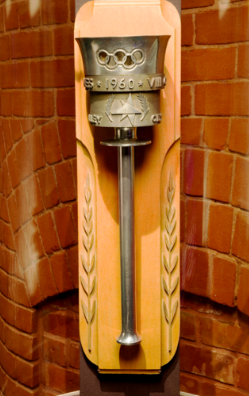The pageantry. The spectacle. The national pride. The sheer athletic power and precision. It is impossible not to be inspired by the fanfare and excitement surrounding the Olympics. While the world turns its attention towards the thrilling events taking place in London, we at The Walt Disney Family Museum cannot help but to look back in time fifty years to the 1960 Winter Olympics, held near Lake Tahoe, California, for which Walt Disney served as the Chairman of the Pageantry Committee.

As Chairman, Walt’s duties included staging the Opening and Closing Ceremonies, scheduling nightly entertainment for the athletes, providing decorations to enliven the valley, and taking care of a number of logistical details including parking concerns, security, and ticketing systems. He enlisted the help of a number of seasoned employees of WED, Walt’s namesake company in charge of the design and development of Disneyland, (and forerunner to Walt Disney Imagineering). The WED artists and designers’ knowledge and experience with similar challenges proved useful during the planning of the Olympics Games.
Veteran Disney artist John Hench designed the 1960 Winter Olympic torch, which can be seen on display in the museum at the bottom of the ramp in Gallery 9. Hench’s impressive 65-year tenure with the Disney company spanned positions in the Animation Department, in Special Effects for live-action films, and at WED working on Disneyland. The Olympic Torch is arguably one of his most distinguished design accomplishments.
Though the design was modeled after the torches for the 1948 and 1956 Olympiads, Hench decided on a slightly smaller version that would be easier for torchbearers to carry. The earlier, taller models proved to be difficult to manipulate as they were top heavy when filled with fuel. Hench also added black tape to the top part of the shaft to enable runners to pass the torch easily and ensure a stable grip. A number of subsequent torch designs would be greatly influenced by Hench’s 1960 model.
In 1990, Hench was inducted into the prestigious Disney Legend program, joining the ranks of the great Disney designers, artists, and performers.
Hench’s design for the torch was just one piece of the legacy left behind by the 1960 Winter Olympics. For example, it was during these games that the term “instant replay” was first coined. The closing of the men’s slalom race appeared to be too close for officials to call, so they requested that CBS television replay the video of the race in order to determine the victor conclusively. Over time, the technology of the instant replay has been developed to ensure the awarding of the proper victor.
In addition, it was during the 1960 Olympics that Walt was introduced to world class ski instructor Willy Schaeffler. The two formed a strong bond and began plans together to develop a family-friendly ski resort in Mineral King Valley.
By the 1960s, Walt Disney had fully emerged from the filmmaking industry to become a world-renowned showman and multimedia entertainer. The projects he undertook during the last few years of his life (including the 1960 Olympics, plans for an ideal live-work community for his Florida project, a college for the arts in Southern California, four attractions for the New York World's Fair in 1964, and a family-friendly ski resort for Mineral King Valley, to name a few) confirmed the brilliance of Disney storytelling, transcending both page and screen.

Alyssa Carnahan
Museum Educator
